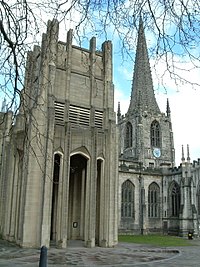Sheffield Cathedral
| Sheffield Cathedral | |
|---|---|
| Cathedral Church of St Peter and St Paul | |
 |
|
| Coordinates: 53°22′59″N 1°28′10″W / 53.3830°N 1.4694°W | |
| Location | Sheffield, South Yorkshire |
| Country | England |
| Denomination | Church of England |
| Website | sheffieldcathedral.org |
| Architecture | |
| Architect(s) |
Flockton & Gibbs(1870s) Charles Nicholson (1936–48) George Pace and Ansell & Bailey (1960–66) |
| Style | Gothic, Modernist |
| Years built | c.1200-1966 |
| Administration | |
| Diocese | Sheffield (since 1914) |
| Province | York |
| Clergy | |
| Dean | Peter Bradley |
| Precentor | Simon Cowling |
| Canon(s) | Joanne Grenfell, DDO Chris Burke, Canon for Learning and Development |
The Cathedral Church of St Peter and St Paul, Sheffield, usually called simply Sheffield Cathedral, is the cathedral church for the Church of England diocese of Sheffield, England. Originally a parish church, it was elevated to cathedral status when the diocese was created in 1914. Sheffield Cathedral is one of five Grade I listed buildings in the city, along with Town Hall, Abbeydale Industrial Hamlet, and the parish churches at Ecclesfield and Bradfield. It is located in the city centre on Church Street and served by Sheffield Supertram's Cathedral stop.
The site of the cathedral has a long history of Christian use. The shaft of the 9th-century Sheffield Cross, believed to have formerly been sited here, is now held by the British Museum. It is probable that Sheffield's parish church, a satellite of Worksop Priory, was constructed here in the 12th century by William de Lovetot at the opposite end of the town to Sheffield Castle. This established the area of the parish of Sheffield, unchanged until the 19th century. This church was burnt down in 1266 during the Second Barons' War against King Henry III.
Another parish church was completed in 1280, but this church was mostly demolished and rebuilt about 1430 on a cruciform floor plan. The Shrewsbury Chapel was added in the next century, and a vestry chapel (now the Chapel of Saint Katherine) was added in 1777. The north and south walls of the nave were rebuilt in 1790–93 and a major restoration by Flockton & Gibbs, which included the addition of new north and south transepts, was completed in 1880. The church was originally dedicated to Saint Peter, but from some time after the reformation into the 19th century it was dedicated to Holy Trinity; it has since been dedicated to both Saint Peter and Saint Paul.
...
Wikipedia

